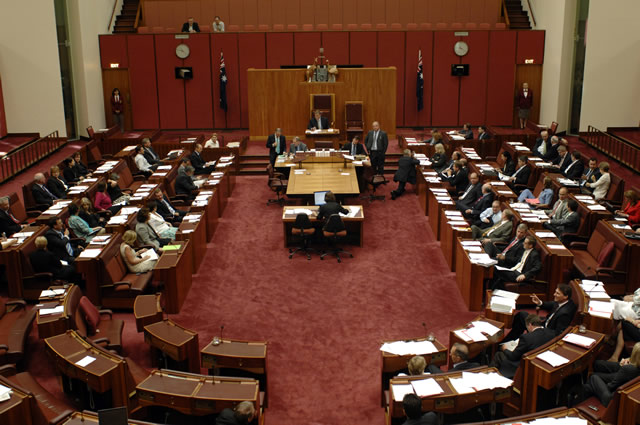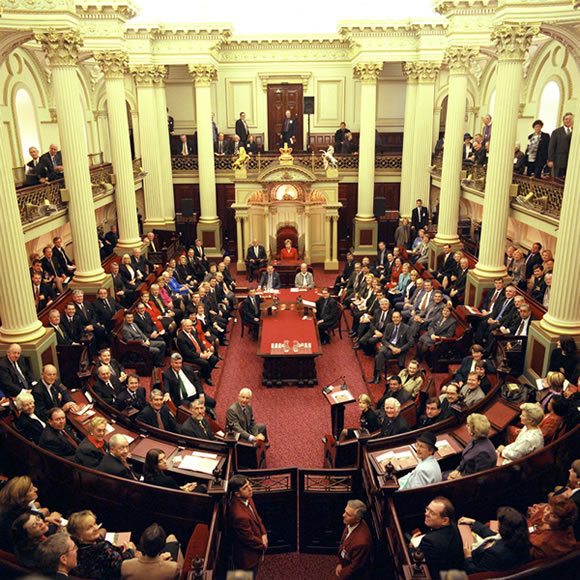185 Conduct of senators
-
A senator shall acknowledge the chair on entering or leaving the chamber.
-
A senator shall not pass between the chair and a senator who is speaking, nor between the chair and the table.
-
A senator on entering the chamber shall take the senator’s place, and shall not stand in any of the passages.
Amendment history
Adopted: 19 August 1903 as SOs 390 to 392 (corresponding to paragraphs (1) to (3)) but renumbered as SOs 386 to 388 for the first printed edition
1989 revision: Old SOs 400 to 402 combined into one, structured as three paragraphs and renumbered as SO 185; removal of archaic references in paragraph (1) to senators being “uncovered” when entering or leaving the chamber; “make obeisance” replaced with “acknowledge”; expression streamlined
Commentary

The Senate chamber (Photo courtesy of AUSPIC)
Like the previous standing order, SO 185 reflects universal practice. The purpose of these rules is to reinforce the primacy of the Chair, to ensure physical orderliness and to preserve the line of sight between the Chair and the senator with the call.
Another proposed standing order in this group was fiercely debated in 1903 and ultimately negatived following unsuccessful attempts to amend it. It provided that:
No senator shall turn his back to the Chair when speaking, or shall unnecessarily stand or sit with his back to the Chair.
In the end, it was regarded as an unnecessary lesson in courtesy but it triggered debate on an issue that some senators had clearly found unusual; namely, the practice of President Baker of contributing to debate in committee of the whole from the President’s chair, behind and above that of the Chairman of Committees.[1] In fact, given the configuration of the Legislative Council chamber in Melbourne where the Senate met till 1927, the President was not the only senator to be located to the rear of the Chairman. The two end seats in the front benches on either side were also technically behind the Chairman. It is now the practice for the President to participate in any committee of the whole proceedings from the duty minister’s seat at the end of the government front bench, on the basis that the President would usually be participating as a de facto minister, taking a relevant bill through the committee stages.[2] The issue of where the President might sit to participate in any committee of the whole deliberations on Procedure Committee reports has not arisen since the chairmanship of that committee moved from the President to the Deputy President in 1994. Presumably, the matter could be settled by the President, in consultation with senators, using his or her powers under SO 48. Failing that, it could be settled by resolution.

In the chamber of the Legislative Council of Melbourne, where the Senate met till 1927, President Baker participated in the standing orders debate in committee of the whole from his own Presidential chair behind the Chairman of Committees (Photo courtesy of AUSPIC)
Surprisingly few archaic references needed modernizing in the course of the 1989 revision but one of these was the reference in the original version of SO 185(1) to senators being “uncovered”.[3] As the notes tabled with the first draft of the revised standing orders in May 1988 explained:
… this is obviously a relic of the time when the wearing of hats was common. It is suggested that, as with other requirements of dress, this be left to practice. SO 400 also refers to Senators making “obeisance” to the Chair. The suggested substitute provision is that Senators “acknowledge” the Chair.[4]
The suggestion was adopted. Acknowledgment of the Chair takes the form of a neck bow or nod by senators and clerks at the table as they enter or leave the chamber.